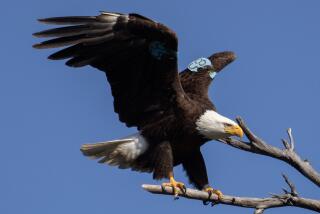BREEDING BIRDS: LAZULI BUNTING
- Share via
LAZULI BUNTING
(Passerina amoena)
Description: Adult male has bright turquoise back and throat. Its belly is white, breast and sides are cinnamon. Has two white wing bars, the upper bar wider. Female’s back is grayish-brown; rump is grayish-blue; underparts white, with buffy wash on throat and breast.
Habitat: Common around open deciduous or mixed woodlands, chapparal. Particularly attracted to brushy areas near water.
Diet: Insects, seeds.
Displays: Courtship: male flutters on ground with extended, trembling wings.
Nest: Coarsely woven of dried grass, forbs, lined with fine grasses and hair.
Eggs: Pale bluish-white, unmarked.
Natural history notes: Riparian thickets formed by agricultural irrigation have provided new habitats, therefore increasing the number of Lazuli Buntings in this century. But suburbanization of wooded areas is decreasing this formerly common habitat.
Breeding bird atlas: To report bird breeding activity in your neighborhood, or to get information on the breeding bird atlas (now in its fifth and final year), call Sea and Sage Audubon Society members Sylvia Gallagher, (714) 962-8990, or Nancy Kenyon, (714) 786-3160.
Note: Map is divided into 5-kilometer squares so that Audubon Society volunteers can more easily survey areas on a regular basis.
Sources: Sea and Sage Audubon Society; “The Birder’s Handbook,” Ehrlich, Dobkin and Wheye, Fireside Books (1988); “Field Guide to the Birds of North America,” National Geographic Society (1987); “Birds of Southern California: Status and Distribution,” Garrett and Dunn, Los Angeles Audubon Society (1981).
Indicates 5-kilometer-square areas where breeding activity has been confirmed.
More to Read
Sign up for The Wild
We’ll help you find the best places to hike, bike and run, as well as the perfect silent spots for meditation and yoga.
You may occasionally receive promotional content from the Los Angeles Times.




